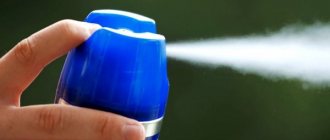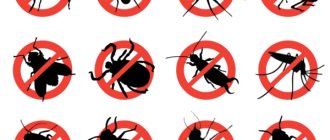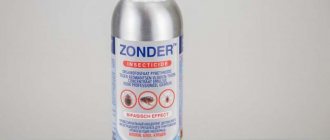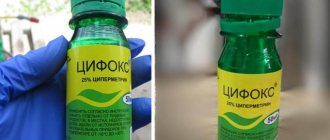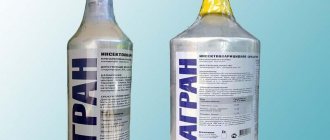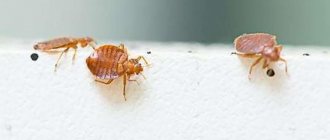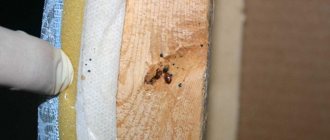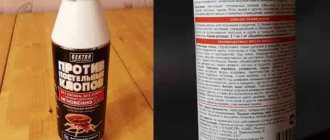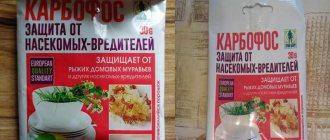Insect control has long become a daily occurrence in the modern world. There are many products that are used for different purposes: getting rid of parasites in the house or in nature (in vegetable gardens, garden plots). The most famous and widely used drug is dichlorvos.
This remedy has been so popularized since Soviet times that in our time it has already become a household name for many people. You should understand in detail what kind of remedy this is, whether it can harm people and what actions to take if the toxin enters the body.
Dichlorvos - what is it?
Everyone should know dichlorvos poisoning, symptoms and methods of treatment, especially taking into account its chemical characteristics. This is an organophosphorus substance that has some advantages:
- the ability to effectively influence any type of insects,
- the potential for poisoning through contact, inhalation of vapors or by ingestion,
- poses relatively little danger to humans or warm-blooded animals,
- in the environment can decompose quite quickly,
- Absolutely harmless to plants.
But this substance also had some disadvantages, which only intensified with the emergence of new generations:
- high-quality ventilation was required for indoor processing,
- there was a possibility of poisoning for people, since the drug can have a strong effect on the nervous system,
- the substance could be inhaled in confined spaces, with a lethal dose for humans being 0.5–2 g if ingested.
Dichlorvos: modern types and their correct use
Today you can find many drugs united by one name - “Dichlorvos”. There are various variations of this insecticide, but all of these products are not essentially dichlorvos, because they have nothing in common with the original aerosol. Meanwhile, it is almost impossible to find a classic drug today, since it has been replaced by more modern and safe insecticides.
Can dichlorvos harm humans?
If we look at aerosol cans called dichlorvos, we can notice the presence of pyrethroids in the composition. Auxiliary components include preservatives, alcohol and hydrocarbons.
For insects, pyrethroids pose a great danger, as they can cause paralysis and death in just a few hours. They can cause minor harm to humans. While in the human body, under the influence of the liver, permethrins break down into metabolites that are safe for humans. As a result, dichlorvos poisoning is possible, although the probability is low.
Precautions to keep your pet safe
If a cat lives at home, then instead of aerosols and gels it is safer to buy special insect traps that will not harm the animal.
If the apartment needs to be treated with dichlorvos, then the pets need to be taken out for 2-3 days. At a minimum, cats should be in another room behind a tightly closed door. After spraying, you need to open all windows for 4-5 hours. The surface on which particles of a toxic substance may remain must be thoroughly washed with regular soap without additives. It is not recommended to use household chemicals because they are harmful to your pet's health. It is important to remove dead insects and evict any survivors, since if a cat starts hunting and eats a poisoned fly or cockroach, it will most likely become poisoned. The downside of the product is that partially damaged insects will be slow and may catch the cat’s eye.
If you suspect that your pet has been poisoned, you need to induce vomiting. To do this, you can inject salt water into a syringe without a needle. It is also important to quickly take the animal to the veterinarian. With prompt medical care within the first 12-24 hours after intoxication, negative consequences can be minimized.
Symptoms of poisoning
You can get poisoned in several ways: by getting into the digestive system, on the skin, or by inhaling vapors. Despite the breakdown of substances in the body into non-toxic ones, children, pets (cats are especially sensitive) and people prone to allergies should be wary; dichlorvos can harm them.
If the drug comes into contact with the skin, there is a possibility of a hypersensitive reaction:
- swelling, skin irritation,
- tingling,
- burning.
If vapor inhalation occurs, symptoms are as follows:
- body temperature rises,
- facial skin becomes very sensitive,
- dizziness,
- inflammation of the mucous membranes of the nasopharynx,
- cough, increased irritability of the respiratory tract,
- migraine.
Symptoms often go away within three days. If the toxin gets into the eyes, the mucous membrane may turn red, the eyes hurt, tear production increases, that is, conjunctivitis may develop.
Are there any complications?
Often, entry into the body through the respiratory tract or skin does not pose a great danger; symptoms disappear within a short period of up to three days. But more serious consequences are possible when an individual organism is intolerant to any component of the drug or with prolonged contact. In such cases, you can notice obvious intoxication of the body.
In severe poisoning, paroxysmal coughing, increased blood pressure, increased cardiac activity, and repeated vomiting are observed. If spasms of internal organs and convulsive syndrome appear, these are the most dangerous signs. If any are present, collapse may occur, and perhaps even a coma will develop.
What to do if you are poisoned by a gaseous substance?
In case of vapor intoxication, it is necessary to immediately remove the victim to fresh air. It is necessary to rinse your mouth with a solution of water and baking soda or clean warm water. To minimize the harm of the toxin, you should also wash exposed areas of the body and change into clean clothes, then provide bed rest.
If the toxin ends up in the stomach, you should definitely induce vomiting, take sorbents, and then take magnesia, Glauber’s salt, or any saline product with a laxative effect within an hour and a half.
What to do if the toxin gets into your eyes or skin?
If the substance gets on the skin, it is necessary to remove it with a cotton pad, the main thing is to avoid rubbing it into the skin, otherwise the harm will only increase. Then treat the affected area with a solution of ammonia (5–10% is enough). In case of contact with the eyes, rinse them with warm, clean water, and then drip a few drops of albucid.
Release form and instructions
The drug is available in aerosol form. Available in 190 ml and 600 ml cans. The cost of small cylinders starts from 150 rubles, large ones - from 275 rubles. Detailed instructions for use of odorless Dichlorvos Neo are placed on the packaging
Basic precautions and conditions of use:
- Do not use during pregnancy, near children or persons over 70 years of age,
- do not spray at temperatures below +10 °C,
- do not heat the cylinder above +40 °C,
- Use no more than 1 package (190 ml) during the day.
The standard consumption of the substance when pressing the button at full force is 20 ml per second of spraying. The instructions for odorless dichlorvos establish additional consumption limits depending on the size of the room:
- for an area of up to 18 square meters, the total spraying time should not exceed 7 seconds,
- with an area of 18-28 square meters, you cannot use more than 200 ml of the drug.
Violation of processing rules is deadly. Care is required when working: do not spray the aerosol directly on personal belongings, pet hair, children's toys, food and medicine (as well as places where they are stored).
Preparing for disinfestation
Complete disinfestation of a premises takes place in several stages. It is necessary to warn neighbors in advance about disinfestation so that they promptly close doors, windows, balconies and ventilation ducts. Special clothing and personal protective equipment are being prepared:
- Overalls or old unnecessary clothes with long sleeves and trousers. If clothes do not absorb water vapor, they can be reused after rinsing. It is better to throw away clothing that absorbs moisture.
- Be sure to wear rubber gloves, a respirator, protective plastic glasses, and thick shoes.
They open passage to all hard-to-reach places where pests can live. Be sure to move furniture away from the walls, clean the space under the water pipes, and if possible, remove the baseboards. Personal items must be packed in vacuum sealed plastic bags:
- products,
- medicines,
- towels,
- bedding,
- personal hygiene products (washcloths, toothbrushes),
- Kids toys,
- pet things, except bowls and trays.
Immediately before spraying, children, elderly people, and pets are removed from the house. Trays and bowls for animals, bird cages, and an aquarium with fish are removed from the house. Pests are poisoned with hermetically sealed doors, windows and ventilation ducts.
Room treatment
Shake the container before use. Spraying duration is no more than 5 seconds. The balloon is quickly moved along the surface to be treated and held at arm's length. Maintain a distance of 25-30 centimeters to the target.
Dichlorvos is most effective when it comes into direct contact with pests, but it is also possible to spray the product in places where they accumulate:
- Flies, mosquitoes - glass, window frames, doorways, cabinets. Spray the rest of the aerosol into the air near the accumulation areas.
- Mol - cabinets. Spraying time is 1 second per 1 cubic meter of cabinet volume. Do not treat the internal surfaces of cabinets in which food, medicines, and personal hygiene products are stored.
- Cockroaches and bedbugs - all hard-to-reach places: the backs of cabinets, paintings, carpets, panels, loose wallpaper and the walls behind them, frames and filling of furniture, backs, legs, space along water pipes (especially at entry points), door frames, space under loose linoleum and its inner surface, baseboards and cracks behind them.
- Fleas - all walls up to a height of 1 meter from floor level, animal sleeping places. After disinsection, the animals' sleeping places should be washed or replaced.
- Ants follow ant paths.
After treatment, leave the room for 40 minutes. Upon return, open windows and doors for ventilation for 2 hours. You cannot be inside during ventilation. If after 2 hours you still feel an unpleasant smell and taste in your mouth, dizziness or nausea, then the room has not been fully ventilated. You must immediately go out into fresh air. You can return no earlier than in an hour.
After ventilation, cleaning is carried out. Surfaces with which there is daily contact are wiped with a solution of soap and soda. Hard-to-reach places, if pets do not go there, are left unwashed to prolong the insecticidal effect. Children, sick people, elderly people and pets can be brought into the room 4-5 hours after ventilation, preferably a day after treatment.
https://youtube.com/watch?v=8NhKOTiueT4

